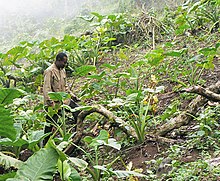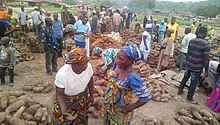

Subsistence agriculture occurs when farmers grow crops on smallholdings to meet the needs of themselves and their families.[1] Subsistence agriculturalists target farm output for survival and for mostly local requirements. Planting decisions occur principally with an eye toward what the family will need during the coming year, and only secondarily toward market prices.[1] Tony Waters, a professor of sociology, defines "subsistence peasants" as "people who grow what they eat, build their own houses, and live without regularly making purchases in the marketplace".[2]: 2
Despite the self-sufficiency in subsistence farming, most subsistence farmers also participate in trade to some degree. Although their amount of trade as measured in cash is less than that of consumers in countries with modern complex markets, they use these markets mainly to obtain goods, not to generate income for food; these goods are typically not necessary for survival and may include sugar, iron roofing-sheets, bicycles, used clothing, and so forth. Many have important trade contacts and trade items that they can produce because of their special skills or special access to resources valued in the marketplace.[3]
Subsistence farming today is most common in developing countries.[3] Subsistence agriculture generally features: small capital/finance requirements, mixed cropping, limited use of agrochemicals (e.g. pesticides and fertilizer), unimproved varieties of crops and animals, little or no surplus yield for sale, use of crude/traditional tools (e.g. hoes, machetes, and cutlasses), mainly the production of crops, small scattered plots of land, reliance on unskilled labor (often family members), and (generally) low yields.
- ^ a b Bisht, I. S.; Pandravada, S. R.; Rana, J. C.; Malik, S. K.; Singh, Archna; Singh, P. B.; Ahmed, Firoz; Bansal, K. C. (2014-09-14). "Subsistence Farming, Agrobiodiversity, and Sustainable Agriculture: A Case Study". Agroecology and Sustainable Food Systems. 38 (8): 890–912. Bibcode:2014AgSFS..38..890B. doi:10.1080/21683565.2014.901273. ISSN 2168-3565. S2CID 154197444.
- ^ Waters, Tony (2008). The persistence of subsistence agriculture : life beneath the level of the marketplace. Lexington Books. ISBN 978-0-7391-5876-0. OCLC 839303290. Archived from the original on 2023-04-05. Retrieved 2023-03-19.
- ^ a b Miracle, Marvin P. (1968). "Subsistence Agriculture: Analytical Problems and Alternative Concepts". American Journal of Agricultural Economics. 50 (2): 292–310. doi:10.2307/1237543. JSTOR 1237543.